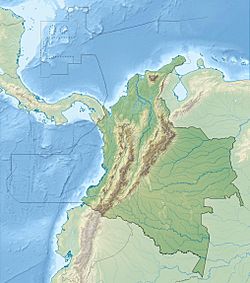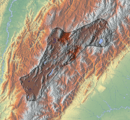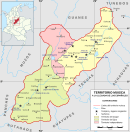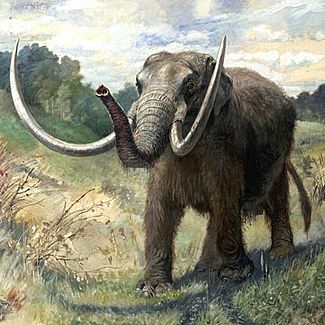Tibitó facts for kids
| Location | Tocancipá, Cundinamarca |
|---|---|
| Region | Bogotá savanna Altiplano Cundiboyacense |
| Coordinates | 4°59′08.4″N 73°58′58.4″W / 4.985667°N 73.982889°W |
| Altitude | 2,555 m (8,383 ft) |
| Type | Rock shelter |
| Part of | Pre-Muisca sites |
| History | |
| Material | Stone & bone tools Carbon |
| Founded | ~11,850 BP |
| Periods | Prehistory-Herrera |
| Cultures | Preceramic-Herrera |
| Site notes | |
| Archaeologists | Gonzalo Correal Urrego |
Tibitó is a very old archaeological site in Colombia, one of the oldest ever found! It's a special rock shelter located near Tocancipá, a town in the Cundinamarca region. This area is in the northern part of the Bogotá savanna, a high plateau in the Andes mountains.
Scientists found old tools made of bone and stone (like knives and scrapers) and pieces of charcoal there. They even found bones from ancient animals like Haplomastodon (a type of mastodon), Cuvieronius (another mastodon), Cerdocyon (a type of fox), and white-tailed deer. These animal bones and tools were found in the deepest layers, showing that humans lived there about 11,740 years ago. The very oldest soil layers at Tibitó were formed from an ancient lake during the Pleistocene Ice Age.
A famous Colombian archaeologist named Gonzalo Correal Urrego led most of the research at Tibitó. He also studied other important early sites in Colombia, like Tequendama, Aguazuque, and El Abra.
Ancient Colombia: A Look Back
The Altiplano Cundiboyacense is a high plateau in Colombia, and the Bogotá savanna is its flat southeastern part. This area was first settled by humans during the late Ice Age. Evidence of these early people has been found at sites like Pubenza (about 16,000 years ago), El Abra, and Tibitó.
Around 30,000 years ago, the Bogotá savanna was covered by a huge body of water called Lake Humboldt. This was a glacial lake, meaning it was fed by melting ice from nearby snowy mountains like Sumapaz Paramo. The lake was enormous, covering about 4,500 square kilometers (1,700 square miles).
An island, now known as the Suba Hills in Bogotá, stood in the middle of this ancient lake. Around the lake, giant Ice Age animals roamed, including Glyptodonts (like huge armadillos), giant sloths, mastodons, and deer.
Over the last 30,000 years, Lake Humboldt slowly shrank. Today, all that's left are the Bogotá River and its smaller streams, Lake Herrera, and many wetlands (swampy areas). Scientists believe the timber line (where trees stop growing) around the ancient lake was much lower than it is today.
Early Human Life in the Andes
During the end of the Ice Age and the beginning of the current warm period (called the Holocene), the first humans arrived on the Andean high plateau. This area is about 2,650 meters (8,700 feet) above sea level.
These early people lived in caves and rock shelters, like Tibitó, all over the Altiplano. They were hunter-gatherers, meaning they hunted animals and gathered plants for food. A very important part of their diet was the white-tailed deer (Odocoileus virginianus). They also caught fish from the many lakes that existed back then.
| Timeline of inhabitation of the Altiplano Cundiboyacense, Colombia | |
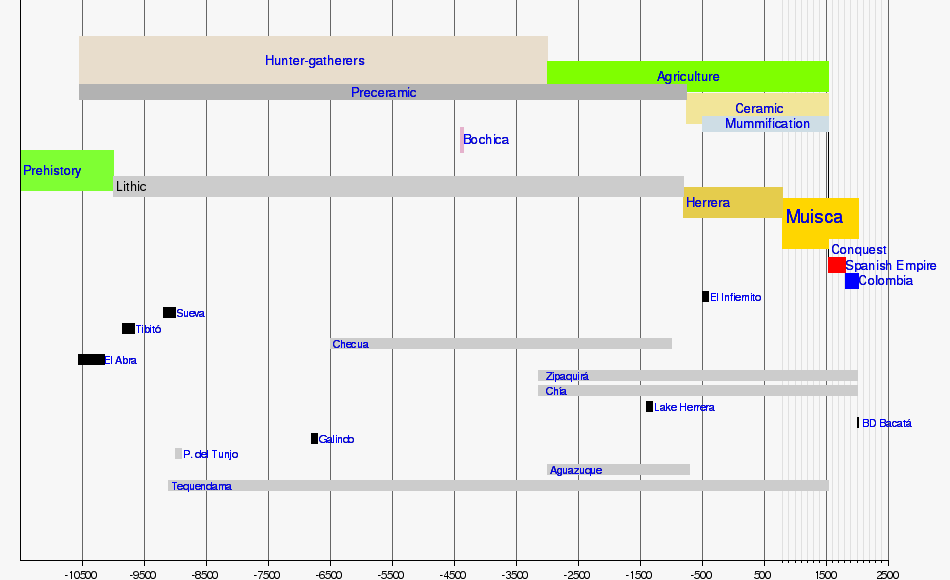 |
|
Discoveries at Tibitó
Scientists used a method called radiocarbon dating on a deep layer of clay at Tibitó. This showed that the site was part of a lake environment about 52,000 years ago. Similar ancient lakes also existed in other valleys nearby, like the Ubaté-Chiquinquirá Valley.
The climate changed a lot during the late Ice Age. There were wet periods that washed away older lake clays, and then cold, dry periods. During these times, hunter-gatherers lived in the valleys.
At Tibitó, researchers found bones from huge, extinct Ice Age animals like Cuvieronius, Haplomastodon, and Equus amerhippus (an ancient horse). They also found bones from animals still alive today, like white-tailed deer and crab-eating fox. These bones were found in a circular pattern, some burnt and some not, mixed with stone tools and pieces of limestone.
Many important Cuvieronius bones were found in this area, especially at Tibitó and Mosquera. Archaeologist Gonzalo Correal Urrego studied 156 stone tools, mostly knives, along with charcoal and bone tools. Almost all these finds were made from materials found locally.
The bones, especially those from Haplomastodon and the ancient horse, were carbon-dated to be about 11,740 years old. This age was also supported by studying ancient pollen (called palynological analysis), which showed that the climate at that time was like a cold, high-altitude páramo. This makes Tibitó slightly younger than the oldest site found in the area, El Abra, which is about 12,400 years old.
Close to Tibitó, some ancient rock art (drawings on rocks) has also been discovered.


